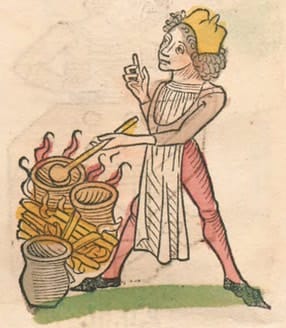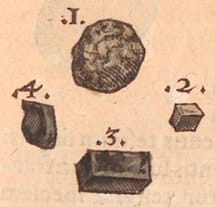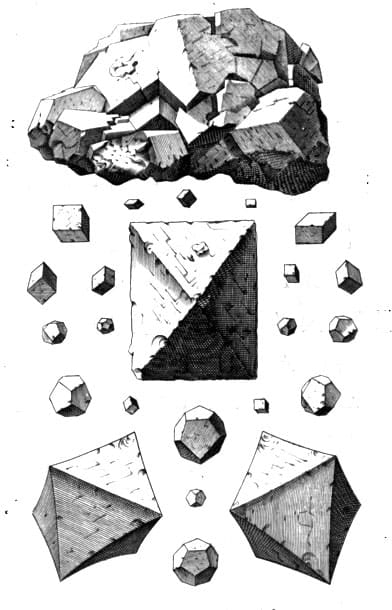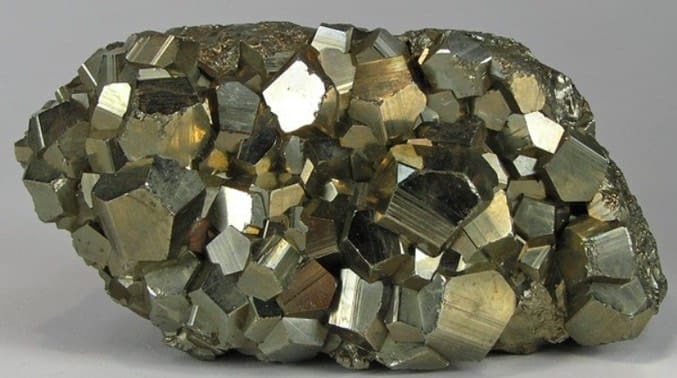Pyritum, Iron Pyrite, Zi Ran Tong 自然铜
Pyrite; Vulcan’s Stone: Lapis luminaris: Hephaestites: Lapis aerarius: ‘Fire Stone’:Zi Ran Tong (TCM)
Vimala Makshik (Ayurveda)
Pha Bang Long Bu ཕ་བང་ལོང་བུ་ (Tibetan Medicine)
Marqashitha (Unani, from which our ‘Marcasite’ comes)
 Hortus sanitatis, 1491
Hortus sanitatis, 1491 Conradi Gesneri de Rerum Fossilium Lapidum et Gemmarum, 1565
Conradi Gesneri de Rerum Fossilium Lapidum et Gemmarum, 1565 Metallotheca Vaticana, Mercati, 1719
Metallotheca Vaticana, Mercati, 1719 Photo: Rob Lavinsky iRocks.com
Photo: Rob Lavinsky iRocks.comMineralogical Name:
Pyritum
Pyrite is a compound of Iron, Copper and Sulphur. That in which Iron is more dominant is called Iron Pyrites (here), that with more Copper is called Copper Pyrite.
Marcasite is the same as Pyrite chemically, just of a different crystal form.
Parts used:
Prepared mineral
Several types of Pyrites were traditionally recognised (Lexicon of Alchemy):
- Silver-colored Pyrites: White or Water Pyrites; Silver and/or Copper was smelted from it. ‘I consider that it usually has more Silver than any other substance’.
- Semi-Gold-colored Pyrites: Yellow Pyrites: Yellow Copper: Copper Pyrites: Copper Ore; the Marcasite of the Arabs. It is found in Silver mines, but more often in those of Copper. Copper was smelted from it.
- True Gold-colored Pyrites; it has the most Sulphur.
- Galena-colored Pyrites; a hard species of Pyrite (some said it was a distinct stone); Gold and Silver were smelted from it.
- Grey Pyrites; usually combined with other types of Pyrites. Gold is smelted from it.
- Iron Pyrites: Iron stone. (This is the type most used in Traditional Medicine, and dealt with here)
Avicenna recognised Marcasites of Gold, Silver, Copper and Iron. Dioscorides preferred Copper Pyrites for medicine. Traditional Ayurvedic texts consider Pyrites of Copper and Iron to be similar in effect, but that of Copper to be best. Tibetan Medicine likewise recognised Iron and Copper Pyrite and uses them the same.
Temperature & Taste:
Neutral, Pungent
“Hot in the second and dry in the third degree” (Avicenna)
Classifications:
K. Move the Blood
Uses:
1. Moves the Blood, Clears Stasis:
-pain and swelling from Trauma, Sprains, Bruising, Hematomas
-Heals ruptured vessels (Tibetan Medicine)
-pain and accumulations from Blood stagnation
-hard Swellings including endemic Goiter
-to stop excess Menstruation (Paracelsus, Salmon)
2. Heals Bone Fractures:
-Fractures; said to promote rapid healing of bones (TCM, Tibetan Medicine, Ayurveda)
3. Strengthens Eyes, Clears the Eyesight:
-to clear the Eyesight (Galen, Dioscorides)
–‘Application both in burnt or unburnt forms strengthens and cleanses the eyes’ (Avicenna)
-Eye disorders (Tibetan Medicine)
4. Strengthens the Kidneys:
-Aphrodisiac (Ayurveda)
-Promotes Conception (West; Hippocrates, Salmon)
5. Externally:
-topically for leukoderma, pityriasis and freckles (Avicenna)
-topically for hard swellings and tumors
-helps clear pus
-promotes granulation of Ulcers and stops unhealthy growth of flesh in Ulcers and Wounds (Avicenna)
Dose:
“Its effects are not manifested unless it is well powdered” (Avicenna)
Decoction: 3–9 grams, decocted for 30–45 minutes before adding herbs)
Prepared Powder: 300mg–600mg
The Bhasma is used in doses of 125–250mg with Honey
Preparation:
1. Calcined Pyrite:
It is calcined to reduce its poison.
Purification of Iron Pyrite (Ayurveda)
Several methods of purification may be used:
1. Iron Pyrite is mixed with a quarter its quantity of Sulphur. It is triturated for a day in mortar with Lemon juice. It is then washed and dried. This process is repeated 7 times.
2. Iron Pyrite is to be boiled with decoction of Adhatoda vasica and Triphala.
3. Heat until red hot, then quench in a decoction of Triphala. Repeat 7 times.
4. Iron Pyrite may be purified as for Copper Pyrite.
Purification of Marcasite. (Ayurveda)
3 parts of powdered Marcasite is mixed with 1 part of Rock Salt and 5 parts fresh Lemon juice. The mixture is put into an iron pan with a thick base and heated over a fire. After the juice evaporates, the powder is heated and stirred constantly until the pan is red hot. Then remove from the fire, and let cool. When cool, the powder should be washed with water 4 or 6 times to remove the Salt. This may then be submitted to Bhasma.
Main Combinations:
1. Trauma, Bruising, Pyrite with Frankincense, Myrrh, Dragons Blood (internally and topically)
2. Pain from Blood stagnation, Pyrite with Paeonia Chi Shao
3. Fractures:
i. Pyrite with animal bone (traditionally Tiger bone, now other animal bone is used). (TCM)
ii. Pyrite with Dang Gui, Notoperygium Qiang Huo, Drynaria Gu Sui Bu, Frankincense (Ru Xiang)
4. Wind-Cold-Damp Joint pain, Pyrite with Myrrh (Mo Yao), Frankincense (Ru Xiang), Cinnamon twig (Gui Zhi), Achyranthes Niu Xi, Eucommia Du Zhong, Saposhnikovia Fang Feng, Ephedra Ma Huang, Licorice (as in Shu Feng Ding Tong Wan)
5. To stop Bleeding, Pyrite with Red Coral, Plantain seed (Paracelsus)
6. Topically for hard swellings, make a plaster of Pyrite with Pine resin (Avicenna)
7. Pyrite is painted on with vinegar for leukoderma, pityriasis and freckles (Avicenna)
8. To remove excess growth of flesh in Ulcers, Pyrite with Orpiment (Avicenna)
Major Formula:
Die Da Wan
Shu Feng Ding Tong Wan
Cautions:
1. Usually only used on a short-term basis, 7–10 days maximum without a break.
2. Cautiously in Blood deficiency.
Main Preparations used:
Bhasma
1. Mineralogical and chemical changes in pyrite after traditional processing for use in medicines.
